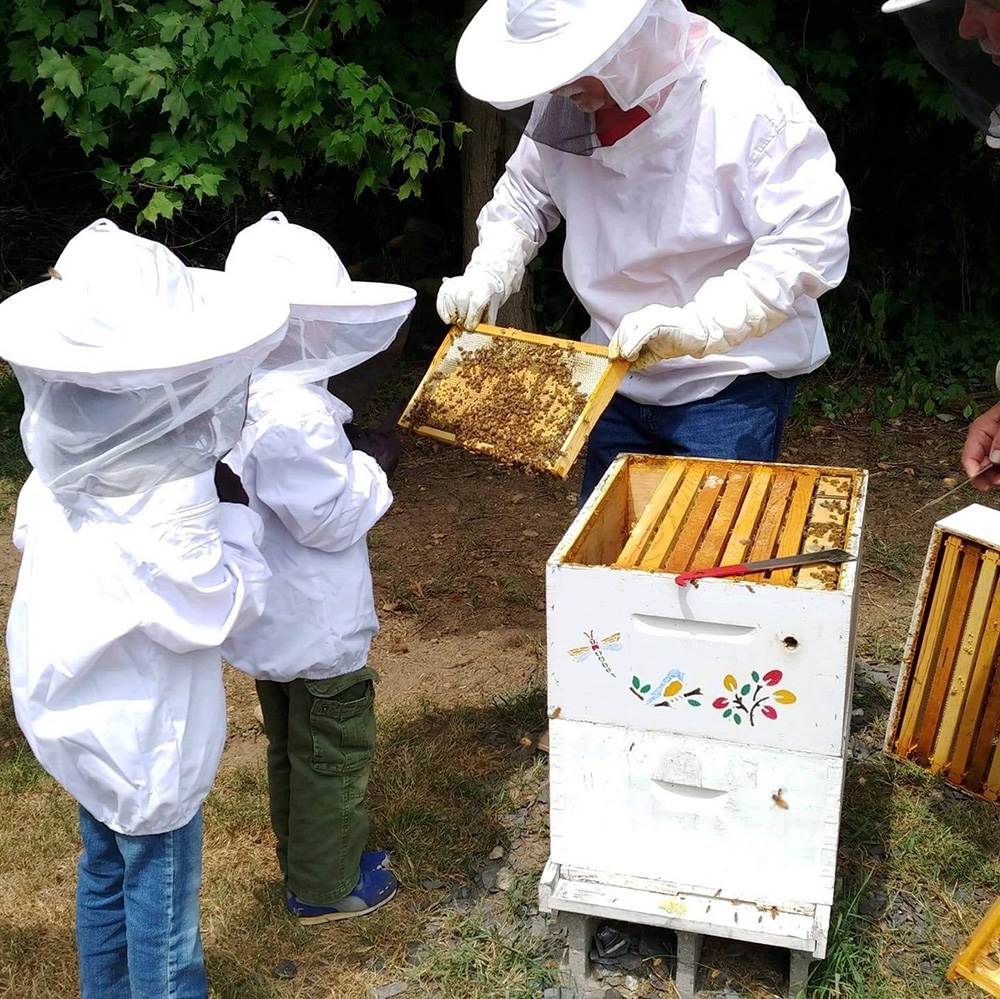 GOOD HONEY COMES FROM HEALTHY BEES…A number of great books have been written on the subject of
GOOD HONEY COMES FROM HEALTHY BEES…A number of great books have been written on the subject of
bee keeping and most people who keep bees know more that we do. So we’ll simply say what seems to work for us.
- Be informed. Join a bee club. We’re members of the Indiana Beekeepers Association and the North Central Indiana Bee Club. We do not get to nearly enough meetings these days but we’ll try to do better this year.
- Keep strong colonies. Do routine inspections…keep good records…and do not tolerate week, low performing queens…kill them and replace them with new ones.
- Control the presence of varroa mites. We use Apivor® brand strips in the fall and spring and fumigations of oxalic acid vapors in the summer.
- Buy quality equipment and quality bees locally. Our primary provider is Bastin Honeybee Farm. We rely on Joe and Ron for sound advice and quality products.
- Learn OTS (One the Spot) queen rearing to control swarms and increase the number of colonies.
Package honey correctly. We’re focused on producing raw honey. The difference between what we produce is that the honey you buy at the supermarket is probably pasteurized (Heated and filtered) to prevent crystallization. This also removes many of the nutrients that give raw honey its unique health benefits.
Market honey correctly. We give most of our honey away but it’s still important to us that branding, packaging and merchandising be done well. So we’ve invested in a food grade honey packaging and professional labeling with the appropriate caution regarding feeding honey to infants (Don’t do it.)
Focus on bee health not honey harvest. It took a while to get this. But we’ve learned to not have honey goals. Instead, establish good bee success goals and let the bees worry about making the honey.
Item 3 above speaks to what may be one of the more important hive health issues…so, let’s dig into that a bit more.
Varroa Mite Infestation Management
The goal is to manage the level of mite infestation at or below 3% of bees tested through a program of integrated pest management (IPM). At Springboro Tree Farms our IPM system includes:
- All-colony application of Apivor® brand strips applied immediately after the honey harvest in August and again in February before marketable honey is present.
- Selective fumigations of oxalic acid vapors in the summer (June-September as needed).
- Selective use of OTS queen rearing in April/May to break the mite reproduction cycle with broodless colonies in June/July.
We evaluate mite infestations levels in June and again in July or August.
Infestation treatment threshold: Mites on 3% of bees
We tend to favor one of two detection methods when inspecting/evaluating our hives for varroa mites.
OPTION ONE: Ether (or Alcohol) “Roll”
Benefit: Fast and can be done easily by one person.
Materials:
- A wide-mouth mason jar with a tight fitting lid
- Alcohol or any commercially available engine starter fluid
Brush or shake approximately 300 worker bees sampled from near the middle of the hive into the wide-mouth Mason jar (about 1 ½ inches deep).
Place the lid on the jar of captured bees and spray a short burst (about one second) of engine starter fluid (approximately two teaspoons of alcohol) into the closed container.
After about one minute, gently roll the jar from side to side to coat all of the bees with the ether (alcohol).
If varroa mites are present, about 50% of them will fall off of the bees and adhere to the sides of the jar where they can be counted. (Burgett et al. 1987).
Threshold for treatment calculation: 3% of (50% of 300 bees) = 4 to 5 mites.
OPTION TWO: Powdered-Sugar “Shake”
Benefit: Accurate. Separates 90% of mites from bees.
Materials:
- A wide-mouth mason jar with a two-piece lid. Remove the center portion of the lid and replace with #8-mesh screen
- #8-mesh (3 mm x 3 mm mesh) hardware cloth or any other mesh that will retain the bees while letting mites pass through
- Tablespoon measure
- Powdered sugar
Brush or shake approximately 300 worker bees sampled from near the middle of the hive into the widemouth mason jar (about 1 ½ inches deep). Replace the modified lid and add a heaping tablespoon of powdered sugar through the mesh screen. Roll the jar from side to side to distribute the sugar over all of the bees. Wait a few minutes and roll the jar again. Pour the sugar and dislodged mites through the screen into a white paper plate filled with water. The sugar will dissolve away and the mites will be visible against the white surface of the plate.
The bees can then be returned to the colony where their hive mates will groom them clean because the sugar stimulates the bees’ grooming behavior. The powdered sugar makes it difficult for the mites to adhere to their host, causing the mites to fall off the bees. This technique works well and is considered superior to the ether roll, separating up to 90 percent of the mites from the bees (Ellis 2000, Macedo & Ellis 2001).
Threshold for treatment calculation: 3% (90% of 300) = 8 mites
[Pictured Top: it’s never too early to start learning about bees and how to care for them. We love showing kids – young kids and old “kids” – our bees.]
